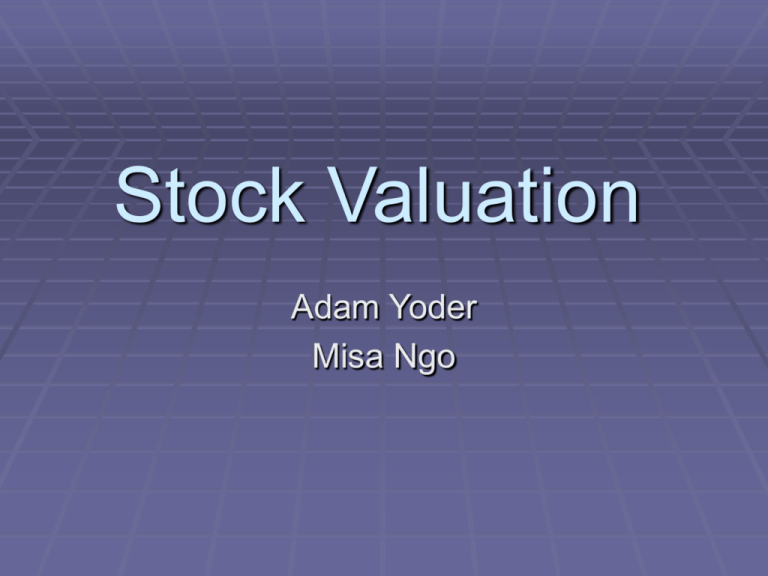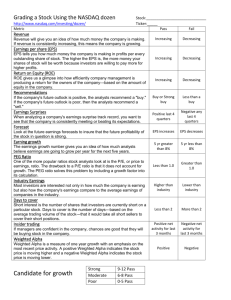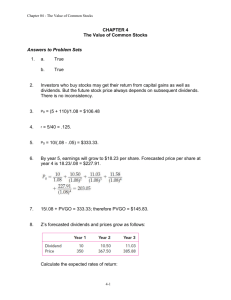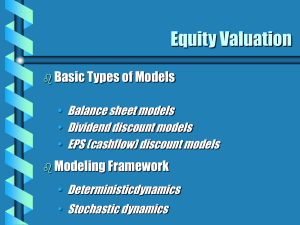Section N
advertisement

Stock Valuation Adam Yoder Misa Ngo Valuation methods Discounted Cash Flow: Dividends Present Value of Growth Opportunities P/E ratio: Price/ Earnings PEG ratio: PE/ Growth Discounted Cash Flow Model Formulas: Div 1 P0 rg g ROE * plowback _ ratio r CAPM rf b(rm rf ) DCF example Corp A: Earnings/shr.=$1 Book equity/shr.=$10 Dividend/shr.=$0.50 ROE= EPS/ book =10% Plowback ratio= RES / EPS= .5 g= ROE * Plowback ratio = 0.1 * 0.5 = 5% r= rf + b(rm-rf) = 0.05 + 0.75(0.1 - 0.05) = 8.75% .5 P0 $13.33 / shr . .0875 .05 DCF Practice Question Corp. B: Earnings/shr.=$3 Book equity/shr.=$15 ROE is 3/15 = 20% Dividend/shr.=$1.75 Risk free rate = 5% Beta on this stock is 1.25 S&P market return is 10% g= ROE * Plowback ratio = 0.2 * .416 = 8.3% r= rf + b(rm-rf) = 0.05 + 01.25(0.1 - 0.05) = 11.25% 1.75 Po $59.32 .1125 .083 Present Value of Growth Opportunities (PVGO) - Net present value of a firm’s future investments EPS1 Po PVGO r EPS1/r: No-growth capitalized value per share (EPS1=DIV1, P0=DIV1/r) Present Value of Growth Opportunities (PVGO) Example ROE = .2 Payout ratio = .6, Plowback ratio = .4 EPS1 = $5.00, DIV1 = $3.00, r = 15% Find PVGO? P0 = DIV1/(r-g) P0 = EPS1/r + PVGO Present Value of Growth Opportunities (PVGO) Example g = ROE x Plowback ratio = .2 x.4 = .8 (8%) P0 = DIV1/(r-g) = 3/(.15-.08) = $42.86 No-growth value = EPS1/r = 5/.15 = 33.33 PVGO = P0 – EPS1/r = $42.86-$33.33 = $9.52 Price/Earnings Ratio (P/E) Amount investors are willing to pay for each dollar of earnings Higher P/E may indicate high growth potential of the firm Current stock price/annual EPS Po d EPS1 rg d: payout percentage (constant) EPS1: next year EPS r: required rate of return g: dividend growth rate Price/Earnings Ratio (P/E) Price of a stock paying dividend D1 at a constant growth rate g P0 Div 1 r g Assume the firm pays out a constant percentage d of its earnings E1 dEPS1 Po (r g ) Divide both sides by E1 Po d EPS rg Price/Earnings Ratio (P/E) Example ROE= .16 d = .7 r= 16% Find P/E ratio? P0/EPS1=d/(r-g) Price/Earnings Ratio Example g= ROEx Plowback Ratio = ROEx(1-d) = .16x(1-.7) = .048 P0/EPS1= d/(r-g) = .7/(.16-.048) = 6.25 PEG Ratio Used by many analysts to determine a valuation when a stock has little or no dividend and high growth prospects. Formulas: PEG = PE / G P0 = g * PEG * EPS Traditional thought is a PEG = 1 is fairly valued Company A: $2 EPS Estimated growth of 15% for next 5 yrs. Fair value is $30 per share. PEG Ratio Recently the PEG ratios have increased significantly due to lower discounting rates in the T-bills. The current S&P PEG ratio is around 1.5 $2 EPS Estimated growth of 15% for next 5 yrs. Fair value is $45 per share. PEG Practice Question Company B: $3 EPS 20% growth over next 5 years 1.4 Industry average PEG Formula: P = g * PEG * EPS P = 20 * 1.4 * 3 = $84 0 0 Questions?





